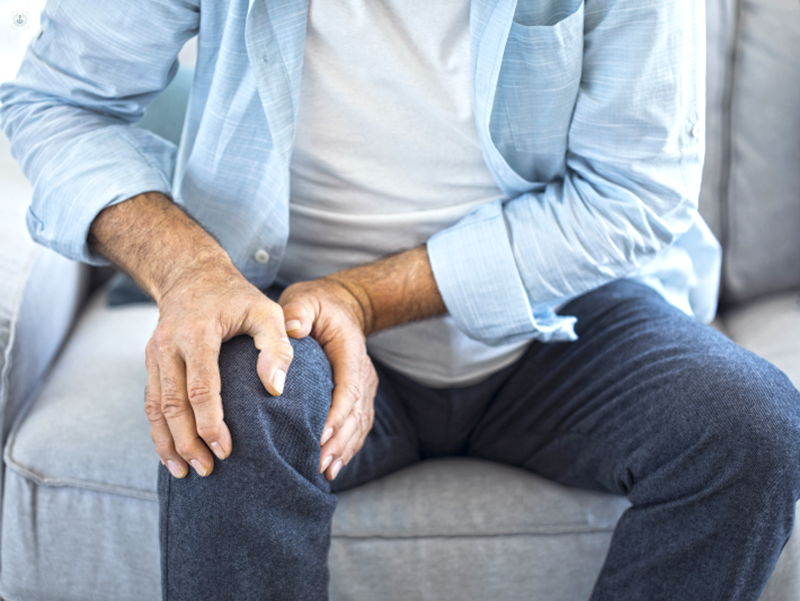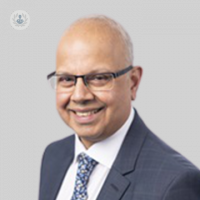How do you treat anterior knee pain? A top orthopaedic surgeon explains
Written by:Pain in the front of the knee, also known medically as anterior knee pain (AKP), can affect anyone at any age and can come from either the knee itself or be referred from the hip or spine. But what causes it and how can it be managed?
Mr Sudhir Rao, a highly esteemed consultant trauma and orthopaedic surgeon, explores the causes of anterior knee pain, when it’s the best time to seek medical care and what treatments are available to help relieve discomfort.

What causes pain at the front of the knee?
AKP can occur from different causes depending on the age group of the patient and requires careful history, clinical examination and appropriate investigations to diagnose the cause.
It is usually related to excessive pressure on knee cap bone as a result of:
- Damage to the lining of the patella
- Maltracking (where the patella does not remain within the central groove of the thigh bone)
- Loss of lining completely (osteoarthritis)
- Inflammation of the tendons from recurrent injuries
- Persistent pain from an injury
A common cause in children is often juvenile anterior knee pain, however, in young active adults it could be due to:
- Patellar maltracking
- Patellar tendinitis
- Anterior meniscal injuries (lateral)
- Fat pad syndrome
- Injuries to the extensor mechanism
In older patients, we often consider osteoarthritis of the patella and/or the rest of the knee, quadriceps and patellar tendinitis and referred pain from the hip to be one of the main causes. It is important to note that rarer causes such as bone tumours must be kept in mind during the diagnosis.
What conditions are associated with anterior knee pain (AKP)?
As mentioned earlier, you must exclude a referred cause of anterior knee pain which can be quite serious such as SUFE (slipped upper femoral epiphysis) in children and hip and spine osteoarthritis in adults.
In the knee, the common causes depend on the age groups. They are often categorised as the following:
- Children — Juvenile anterior knee pain, injury to the patella (extensor mechanism), maltracking, patellar dislocation, overuse pain and rare bone/soft tumours of the patella and distal femur.
- Adults — Sports injuries, patellar and quadriceps tendinitis, patellar maltracking/dislocation, early osteoarthritis, posterior cruciate ligament injury, fat pad syndrome, anterior meniscal tears (lateral meniscus) and rare bone/soft tissue tumours.
- Older — Patellofemoral joint osteoarthritis, patellar and quadriceps tendinitis, maltracking with chondral damage, overuse with pre-existing problems which are not known and finally rare bone and soft tissue tumours of the patella and distal femur.
Complex regional pain syndromes (CRPS) which is pain that appears without an obvious cause, can also occur rarely after injury or after surgery.
What are the symptoms of anterior knee pain?
The pain usually occurs with the loading of the extensor mechanism. The term loading refers to the force put on a weight-bearing joint during activity.
This often takes place during certain sports such as football, rugby and skiing where loading of the patella happens frequently. In addition, walking upstairs and downstairs, kneeling, squatting and doing aerobic exercises or impact activity can bring on the pain. The pain is typically located either above the patella or at the patella and sometimes transfers below to the tibia. Swelling or catching of the knee joint may occur. Another typical association is with a feeling of the knee giving way and feeling weak.
If you are experiencing thigh pain and pain going down to the ankle, then it might be there for a different reason.
When should you seek medical help for anterior knee pain?
In the case of injury-related pain, you should seek help quickly with a doctor or physiotherapist so that appropriate tests can be done to ensure it is not serious.
If the pain comes on gradually and is affecting your daily life, sporting activities or is associated with swelling, giving way, catching, etc. then it is important to seek help from a physiotherapist or a knee specialist. If your GP or physiotherapist has previously treated the anterior knee pain and it hasn’t improved then it’s important to see a knee specialist who in most instances can quite accurately find out the cause of the knee pain and suggest appropriate treatment for it.
Knee specialists can guide you through the activities that may be aggravating the AKP and how to mitigate or avoid it by doing the activity differently.
Most of the time, physiotherapy, exercises, braces, taping, local injections and other conservative approaches are tried before considering surgery, which is often not required.
What surgical procedures treat anterior knee pain?
I perform surgical procedures most commonly on patients who fail conservative treatment and continue to have considerable symptoms that affect their daily life or sporting activities.
The surgical procedures I perform for AKP include:
- Knee arthroscopic (keyhole) surgery to help with assessment and/or treatment of AKP
- Procedures to improve patellar tracking and reduce AKP such as Fulkeron’s procedure +/- lateral release
- Surgery to prevent recurrent dislocations of the patella and improve stability
- Relining of damaged articular cartilage (osteoarticular graft transfer or growing cells such as chondrocyte implantation)
- Complete replacement surgery of the lining of the patellofemoral joint. This is done by replacing it with a polyethene lining (thick strong plastic) of the patella and relining the groove of the femur with a metal lining (trochlea). This is called a patellofemoral joint replacement or can be part of a total knee replacement if the patella was not resurfaced at primary surgery.
Can you treat anterior knee pain without surgery?
There are many alternatives to surgery. These can include:
- Physiotherapy
- Osteopathy
- Reduction and/or alteration of the sport or activity aggravating the pain
- Taping of patella
- Patellar straps and braces
- Local injection of steroids and local anaesthetic
- Intra-articular and tendon injections of steroids, PRP or hyaluronic acid.
In isolation or in combination any of the measures above can make AKP more manageable.
Are the alternatives as effective?
I believe the previous approaches should be tried if they can be done safely. It is important to identify the cause of the pain early so that correct conservative treatment can be suggested.
Very often I see patients who have tried conservative treatments for a long time and it hasn’t worked as the clinical diagnosis was incorrect. As well as wasting a lot of time, repeatably trying conservative treatments can very expensive too! I always suggest that if conservative treatment has not worked after roughly 6 sessions of treatment or 6 weeks of regular treatment then patients should seek help from a knee specialist to look at different options.
Surgical treatment is not always a cure but it is generally quite effective if the cause is identified and then be corrected by an operation. This requires a serious commitment from you, the patient, to get better. It often takes time, sometimes 6 months to a year, to notice the benefits from surgery and the initial period of recovery can take up to 6-8 weeks.
Are there any risks of complications from surgery?
There are risks and complications of surgery which might include persistent pain after the operation, infections, stiffness of the knee, the rare chance of damaging nerves and arteries, DVT and PE, and pain syndrome such as CRPS infrequently be triggered by the surgery. Although it’s important to remember complications are rare, these must be weighed against the potential benefits.
If you are experiencing any of the symptoms mentioned in this article and would like to see a specialist, you make book a consultation with Mr Sudhir Rao via his Top Doctors profile.



